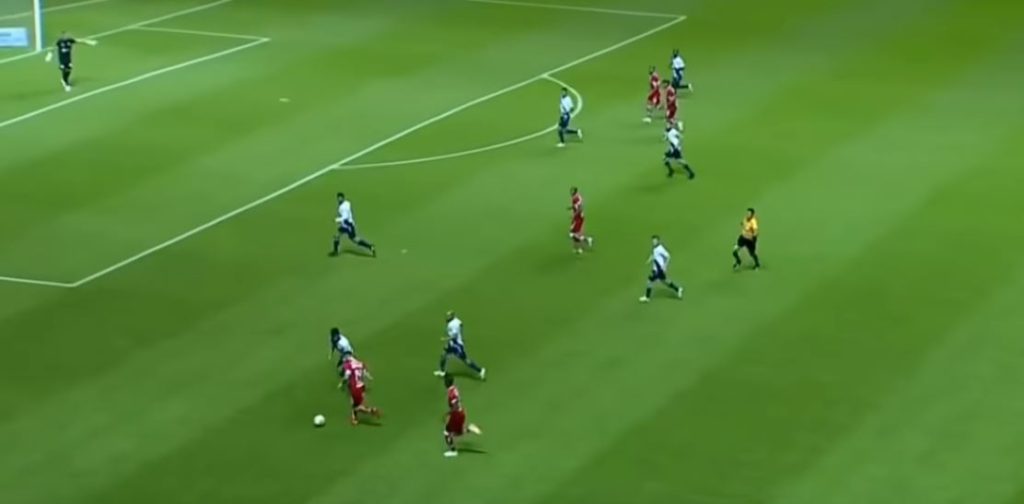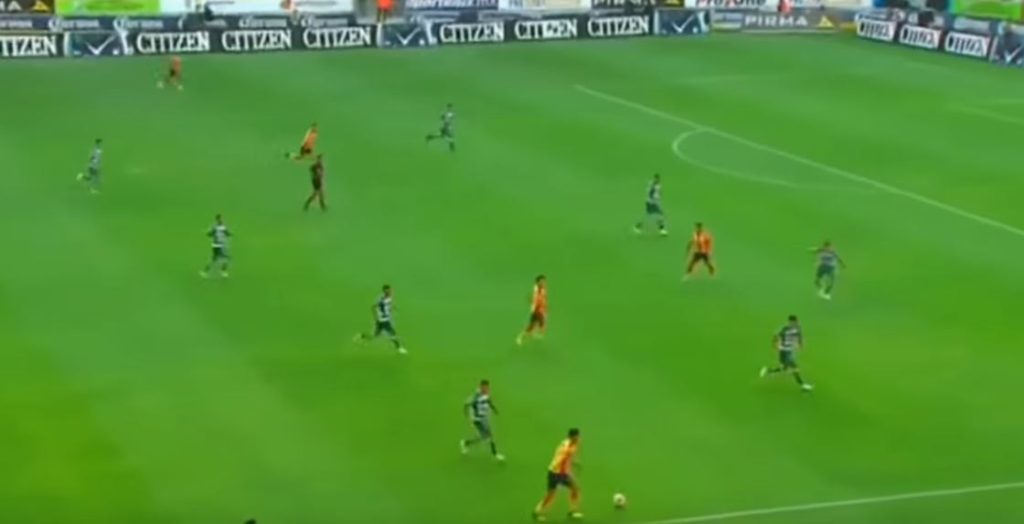In jornada dos of the 2018 Apertura, 16 of 18 Liga MX teams fielded a 4-2-3-1 or 4-4-2, and not a single side used three central defenders. This epitomises the current lack of tactical diversity within Liga MX right now, as the majority of teams face just a single tactical question, whether to use two natural strikers or a “number ten” behind a “number nine”.
Tactics are about much more than numbers in a formation though, and the lack of tactical diversity in Liga MX goes beyond simply the formations chosen. The 4-2-3-1 or 4-4-2 systems are interpreted in extremely similar ways by the vast majority of Mexican top flight coaches, with three concepts seen almost across the board.
La Salida Lavolpiana(ish)
Ricardo La Volpe’s main legacy on the footballing world is the concept of la salida Lavolpiana (the La Volpe exit). This refers to a defensive midfield player dropping in-between split centre-backs when playing out from the back, and is done in order to create a three v two overload when facing two opposing strikers. La salida Lavolpiana was popularised by Pep Guardiola’s Barcelona, when Sergio Busquets dropped into the back-line, and considering La Volpe’s history, has unsurprisingly become a dominant tactical concept in Mexico.
However, there is a question of whether or not it’s been interpreted correctly, illustrated by the example below, from Querétaro’s one-nil victory over Pachuca in jornada dos.

Here, whilst Querétaro’s centre-backs do split, Aldo Arellano didn’t quite drop into the back-line. Instead, he creates a triangle shape with his defenders, which could allow Arellano a good opportunity to turn and play forwards. However, in this example it allows Erick Gutiérrez to step up and man mark him. As a result, Tiago Volpi has no short options and is forced to play long. This shape, with a defensive midfielder in front of, rather than in line with, the split centre-backs is often seen in Liga MX. Whilst it could be described as la salido Lavolpiana, it isn’t the same interpretation that was so successful with Barcelona, and the example above shows why.
The other difference in interpretation is that la salida Lavolpiana in Mexico usually involves one of the two central midfield players dropping in, and in some teams the pair rotate roles. Meanwhile, Guardiola uses a three-man central midfield, and the player that drops in is typically the holding midfielder, whilst two more advanced midfielders look to offer passing options either side. Having an extra midfield player rather than two strikers can offer an additional passing option ,and therefore make it easier to play forwards, through a team, via la salida Lavolpiana.
Two lines of four
The best known method of setting up a defensive shape is to use two lines of four players (one line of defenders, one of midfielders). The 4-2-3-1 and 4-4-2 formations lead into adopting such a shape out of possession, which can prove very difficult to break-down if teams are well drilled, and stay compact to keep gaps between the lines to a minimum.

Querétaro’s shape out of possession here is seen regularly throughout Liga MX. The lines of four defenders and four midfielders are clear, and gaps between the defensive players are kept small. The only real space for Pachuca to play in is out wide, which is less dangerous than a central position.

Another example is seen here from Puebla in their game against Toluca. The defensive line of four is clear, and ahead you can see a line of three midfielders as Francisco Acuna has pushed forward to help press the player in possession. This is referred to as the “three in-one out” concept in ‘Soccer: Modern Tactics’ by Alessandro Zauli. Also, in this example support from one of the two forward players can be observed, another common feature of defending in Liga MX.
Free form attacks
The approaches of world class coaches Pep Guardiola and Mauricio Sarri in recent years has seen the rise of juego de posición (positional play) as a dominant tactical ideology. Simply put, juego de posición is an ideology that focuses on creating numerical superiority or qualitative superiority in certain areas of the pitch. La salida Lavolpiana is an example of how to create numerical superiority, whilst qualitative superiority can be producing a one v one out wide with a winger who has the ability to beat their opposing full-back. Juega de posición demands players to be structured and disciplined with their positions in order to create these scenarios, and whilst players are often able to rotate with teammates, certain positions must adopted at certain times. One example is having players on either touchline when building-up attacks, to stretch the opposing defence as much as possible and offer the opportunity to switch play.
Juego de posición is yet to have much of an impact in Liga MX. In fact, the vast majority of teams adopt almost an opposite approach. Rather than having to be disciplined and constantly adopt certain positions, most Liga MX attackers are given freedom to roam, and often attacking players that prefer to operate centrally are used as “wide players”. The benefit of giving attackers freedom is that it can make man marking extremely difficult for opponents, however, the result of free form attacks often sees all attacking players drift inside, which can be problematic.

Here’s an example of all attacking players moving inside, when Rubens Sambueza has possession for Toluca. The lack of width from Toluca’s attack allows Puebla to maintain a compact defensive shape, with left-back Brayan Angulo shuffling inside. Toluca therefore have a lack of space to play through Puebla and if Sambu was forced to turn around and re-set the attack, there wouldn’t be an option to quickly switch the play to the opposite flank. Doing this would challenge the Puebla defence to maintain their compactness whilst shuffling across to the other side of the pitch, and could result in larger gaps between the Puebla defence being created.
An exception- Roberto Hernández’s Morelia
After years behind the scenes at Morelia, Roberto Hernández has finally received the opportunity to step-up and permanently lead La Monarquía. Hernández has greatly overachieved thus far, keeping Morelia in Liga MX with the dramatic late victory at Monterrey before securing back-to-back top-eight finishes. Throughout his time in charge, Hernández’s Morelia have offered something tactically different to what’s usually seen in Liga MX. Roberto may only play a 4-2-3-1 like much of the other coaches in Mexico’s top flight, but his attacking approach is significantly more structured, and appears to have taken some inspiration from juego de posición.

Above is a situation from the jornada dos match against Santos Laguna. Santos are adopting the usual ‘two lines of four’ defence, with left-back Jesús Angulo pushed out in case he needs to press. Morelia’s shape poses a greater challenge in this scenario than what Santos would usually face in Liga MX though. Ray Sandoval is holding his position wide on the left, which has two impacts. Firstly, José Abella isn’t able to shuffle across as much as he may like to, creating a gap between himself and the centre-backs (compare with Brayan Angulo’s gap to his centre-backs). Also, Sandoval is an option to switch play, and with a player in support, could exploit a two v one overload v Abella, or may have the opportunity to take on Abella one v one.
This sort of shape is seen from other Liga MX teams on occasion, particularly from América and Tigres, but Roberto Hernández’s side stand-out as every week they consistently adopt a more structured attacking shape than Liga MX rivals. This claim can be backed up by observing the wide average positions of their wingers during matches, as well as their heat maps.
“In Mexico, I believe that coaches don’t really build a game plan for every specific game.” This quote from Puebla head scout Jonathan Himelfarb during an interview on The Colorful Kit Podcast Extra adds another aspect to the issue of lack of tactical diversity in Liga MX. The vast majority of coaches set-up their team in a very similar way every match; 4-2-3-1/4-4-2, two lines of four out of possession, and using la salida Lavolpiana (to an extent) and free from attackers to create chances. It’s rare to see a coach alter their system or line-up in reference to their opponent on the day.
The lack of diversity and alterations to tactics in Liga MX can be seen as a major weakness of the division. For the fan, it can make matches less interesting and enjoyable to watch, and for the player, it can limit their footballing intelligence and ability to play in and against different systems and styles. This makes adapting to other leagues, e.g. top European divisions, and international football more challenging, especially if a coach wants to adapt their game plan for a significant European or World Cup match.
For the sake of the Mexican player, and fans of Liga MX, hopefully we’ll soon see more tactical diversity in Mexico’s top flight. This seems unlikely in the league of recycled coaches, but the new crop of young DT’s may bring change, and there’s always the possibility of innovation from abroad.
Comments








